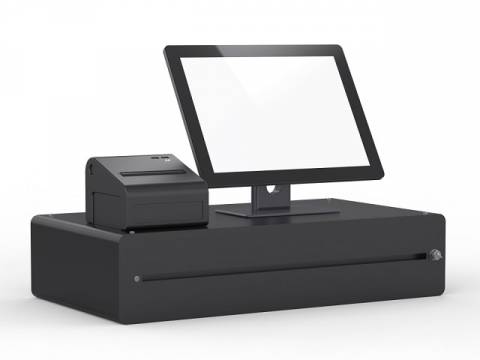
Are you ready to take your business to the next level? Well, it’s time to talk about the unsung hero of modern commerce: POS hardware. This powerful tool is the backbone of every successful retail operation, enabling seamless transactions and efficient customer service. But what exactly is POS hardware? Simply put, it refers to the physical components of a Point of Sale System.
Over the years, POS hardware has come a long way in functionality and design. Gone are the days of clunky cash registers and manual calculations. Today, businesses rely on sleek and sophisticated equipment that integrates seamlessly with POS software, allowing faster transactions, accurate inventory management, and real-time analytics.
Investing in modern POS hardware is vital for any business looking to stay competitive in today’s fast-paced market. With a wide range of hardware accessories, such as barcode scanners and receipt printers, businesses can streamline operations while providing an exceptional customer experience.
So, whether you’re a small boutique or a bustling restaurant chain, upgrading your hardware with cutting-edge solutions like Square Hardware will undoubtedly give you an edge over the competition. Get ready to revolutionize your business with the power of POS technology!
The Importance of POS Hardware in the Retail Industry

Efficient and reliable POS hardware plays a crucial role in enhancing customer service, streamlining transactions, and improving overall operations for retailers. Outdated or malfunctioning hardware can significantly impact sales and create unnecessary hurdles for both customers and employees.
One of the primary advantages of modern POS hardware, such as Shopify POS hardware, is its ability to enhance customer service. Customers can complete their purchases swiftly and conveniently with fast and accurate credit card readers. Gone are when customers had to wait in never-ending lines at the checkout counter. Today’s efficient sale hardware ensures that transactions are processed seamlessly, allowing retailers to serve more customers in less time.
Receipt printers also play a vital role in customer satisfaction. By providing instant receipts after each purchase, retailers can offer their shoppers proof of payment while facilitating returns or exchanges. Moreover, receipt printers enable businesses to include promotional offers or discounts on receipts, encouraging repeat customer visits.
In addition to improving customer service, advanced POS hardware significantly impacts a retailer’s sales and operations. Outdated or malfunctioning equipment can lead to frustrating situations where transactions fail or take an unnecessarily long time to process. Such issues result in lost sales and tarnish the business’s reputation.
Barcode scanners are among the most valuable features offered by modern POS systems. These scanners allow retailers to quickly scan product barcodes during checkout, eliminating manual entry errors while expediting the transaction process. By accurately recording each item’s price and details, barcode scanners ensure that customers are charged correctly while reducing pricing discrepancies.
Integration capabilities between POS hardware and other retail management systems provide additional benefits for businesses. Seamless integration with inventory control software allows retailers to track stock levels accurately in real-time. This ensures that popular products remain available and prevents the embarrassment of selling out during peak hours. With integrated systems, retailers can also automate purchase orders to restock items on time.
Types of POS Hardware Solutions
Different types of cash registers available for various business sizes and needs
One size does not fit all. The first step in finding the perfect system is to consider your business’s size and specific needs. Luckily, different types of cash registers are available that cater to various requirements.
- Basic Cash Registers: These entry-level systems are ideal for small businesses with minimal transaction volumes. They offer basic features such as cash handling, receipt printing, and simple inventory management.
- Mid-range Systems: Designed for medium-sized businesses, mid-range cash registers provide additional functionalities like barcode scanning, employee tracking, and more advanced inventory management capabilities.
- Advanced Point-of-Sale Systems: Large-scale businesses often require robust solutions with comprehensive features. Advanced POS systems offer sophisticated inventory control, customizable reporting tools, integration with other business software, and multi-location management capabilities.
Each type of cash register has its advantages and disadvantages. Basic cash registers are cost-effective but need more advanced features than larger businesses may need. Mid-range systems strike a balance between affordability and functionality. Advanced POS systems provide extensive capabilities but come at a higher price point.
Advantages and disadvantages of traditional versus cloud-based point-of-sale systems
Businesses have widely used traditional point-of-sale systems for decades. However, cloud-based solutions have gained popularity in recent years due to their numerous benefits over conventional setups.
Traditional Point-of-Sale Systems:
Advantages:
- Offline functionality ensures uninterrupted service even during internet outages.
- Lower upfront costs compared to cloud-based alternatives.
- Familiarity – Many employees are already accustomed to using traditional cash registers.
Disadvantages:
- Limited access to real-time data as the information is stored locally.
- Lack of scalability – upgrades or expansions can be costly.
- Maintenance and support require on-site technicians.
Cloud-based Point-of-Sale Systems:
Advantages:
- Real-time data accessibility from anywhere with an internet connection.
- Scalability – easily add or remove registers as your business grows or changes.
- Automatic software updates and backups, reducing maintenance efforts.
Disadvantages:
- Dependence on stable internet connectivity for uninterrupted service.
- Higher upfront costs due to subscription fees and hardware requirements.
- Training may be required for employees unfamiliar with cloud-based systems.
Specialized hardware options for specific industries, such as restaurants or boutiques
Different industries have unique requirements. To cater to these specific needs, specialized solutions have been developed.
- Restaurant POS Systems: These systems include features like table management, order customization, kitchen display integration, and tip tracking. They are designed to streamline operations in busy restaurant environments.
- Retail POS Systems: Boutiques often require inventory tracking for clothing sizes, color variations, and styles. Specialized solutions offer features like barcode scanning, customer relationship management (CRM), and integrated e-commerce capabilities.
- Hospitality POS Systems: Resorts and Hotels benefit from POS systems tailored to their industry needs. These solutions may include room billing integration, spa and activity bookings, loyalty programs, and guest management features.
By choosing a specialized POS system that aligns with your industry’s requirements, you can optimize efficiency and improve the overall customer experience in your business.
Factors to Consider When Choosing POS Hardware
Compatibility with existing software systems and payment processors
When choosing POS hardware for your business, one of the key factors to consider is compatibility with your existing software systems and payment processors. It is essential that the hardware seamlessly integrates with your current setup to ensure smooth operations.
To determine compatibility, start by evaluating the specifications and requirements of your software systems. Check if the POS hardware supports the operating system, database, and communication protocols. Verify if it can connect to your preferred payment processors without any issues.
Here are a few points to keep in mind:
- Ensure the POS hardware is compatible with popular software solutions like QuickBooks or Salesforce.
- Check if it supports multiple payment options like credit cards, mobile wallets, or contactless payments.
- Verify if it can integrate with inventory management systems to track stock levels accurately.
By choosing compatible POS hardware, you can avoid headaches caused by technical glitches or data incompatibility.
Scalability options to accommodate future business growth
Another crucial aspect when selecting POS hardware is scalability. As your business expands, you need a system that can grow along with it. Investing in scalable hardware ensures you won’t have to replace everything when you reach new milestones.
Consider these factors for scalability:
- Expandable terminals: Opt for a modular design that allows you to add more components, like extra registers or scanners, as needed.
- Cloud-based solutions: Cloud-based POS systems offer flexibility and easy scalability since they allow you to manage multiple locations from a central dashboard.
- Integration capabilities: Look for hardware that easily integrates with additional tools like customer relationship management (CRM) software or loyalty programs.
By prioritizing scalability, you’ll be prepared for future growth without reinvesting heavily in new equipment.
Durability, warranty, and support services provided by the manufacturer
The durability of your chosen POS hardware is vital to ensure it can withstand the rigors of daily use in a business environment. Hardware failures can lead to costly downtime and disruptions in customer service. Therefore, it’s crucial to consider the durability, warranty, and support services provided by the manufacturer.
Here’s what you should look for:
- Build quality: Choose hardware made from durable materials that can withstand heavy usage.
- Warranty coverage: Check the length of the warranty period and what it covers, including parts and labor.
- Manufacturer support: Research customer reviews to gauge the manufacturer’s reputation for timely and effective support.
Prioritizing durability, warranty coverage, and reliable support will help minimize potential issues and ensure smooth operations.
Cost considerations, including upfront expenses, ongoing fees, and potential ROI
Cost considerations are significant in choosing POS hardware that fits your budget while providing value for money. Evaluating upfront expenses and ongoing fees associated with the system is essential.
Consider these cost-related factors:
- Hardware costs: Compare prices from different vendors while considering the features and functionalities offered.
- Installation expenses: Determine if there are any additional costs involved in setting up the hardware.
- Ongoing fees: Some POS systems charge monthly subscription or transaction fees; assess if these align with your budget.
- Return on investment (ROI)
Essential Components of a Complete POS System
A complete POS system comprises various essential components that work together seamlessly to facilitate smooth and efficient transactions. These components include the central processing unit (CPU) or terminal, touchscreen monitor, barcode scanner, receipt printer, and cash drawer.
Central Processing Unit (CPU) or Terminal
The heart of any POS system is the central processing unit (CPU) or terminal. This is where the software that powers the entire system runs. The CPU acts as the brain, processing all the information and commands necessary for a successful transaction. It allows businesses to manage sales, inventory, and customer data effectively. Depending on the size and needs of a business, there are different types of POS terminals available in the market with varying features and capabilities.
Touchscreen Monitor
A touchscreen monitor is an indispensable component to ensure user-friendly interaction with the POS system. The touchscreen interface simplifies navigation through menus and options, making it easier for employees to input data quickly and accurately. With just a few taps on the screen, users can select items from stock, enter quantities, apply discounts if applicable, and complete transactions seamlessly.
Barcode Scanner
Efficiently scanning product information is vital in any retail environment. A barcode scanner enables businesses to expedite this process by swiftly reading barcodes on items at checkout. Simply passing an item’s barcode under the scanner’s beam of light instantly transmits its details to the POS system. This saves time for both customers and employees while minimizing errors that may occur during manual entry.
Receipt Printer
Generating customer receipts is an essential part of any transactional process. A POS printer completes this task efficiently by providing immediate documentation for customers’ purchases. Whether it be a thermal or impact printer type, these devices produce clear receipts containing important details such as itemized lists of purchased items, prices, and applicable discounts.
Cash Drawer
Securely storing cash during transactions is crucial for any business. A cash drawer is a necessary component of a POS system, providing a safe and organized place to keep money while completing sales. Cash drawers are often equipped with multiple compartments to separate different denominations and coins, making it easier for cashiers to provide change accurately.
Integrating POS Software and Hardware for Seamless Operations
Benefits of using integrated software-hardware solutions instead of standalone devices
Having an integrated point-of-sale (POS) system that combines both software and hardware is crucial. Unlike standalone devices, such as cash registers or barcode scanners, integrated solutions offer several benefits that can streamline operations and enhance customer experiences.
One of the primary advantages of using integrated software-hardware solutions is the seamless flow of information. With all components working together harmoniously, data from sales transactions can be automatically synchronized with inventory management systems, allowing businesses to keep track of stock levels in real-time. This eliminates the need for manual data entry or potential errors caused by disconnected systems.
Another benefit is increased efficiency at the checkout counter. Integrated POS systems enable employees to process transactions quickly and accurately. For example, barcode scanners can swiftly scan product codes, while printers generate receipts instantly. By reducing manual input and automating processes, businesses can serve customers faster, leading to shorter queues and improved customer satisfaction.
Furthermore, integrated POS systems provide a holistic view of business performance through comprehensive reporting features. These reports can include valuable insights into sales trends, popular products, and revenue streams. Access to this data empowers business owners to make informed decisions regarding inventory management, pricing strategies, and marketing initiatives.
Steps involved in setting up a new point-of-sale system
Setting up a new point-of-sale system may seem daunting at first glance, but following these steps will help simplify the process:
- Evaluate your business needs: Determine the essential features for your specific industry or niche. For instance, a restaurant might require tableside ordering capabilities or integration with kitchen display systems.
- Choose the right hardware: Suitable POS hardware is crucial for smooth operations. Consider factors such as durability, compatibility with your chosen software solution (e.g., Shopify), connectivity options (Wi-Fi or Ethernet), and the ability to support peripherals like barcode scanners, printers, and card readers.
- Select appropriate software: Research different POS software options and choose one that aligns with your business requirements. Look for features such as inventory management, reporting capabilities, employee management tools, and integration with other business systems.
- Install and configure the software: Follow the vendor’s instructions to install the POS software on your chosen workstation or device (e.g., tablet or mobile). Configure settings according to your preferences and ensure proper connectivity with hardware components.
- Set up inventory: Input product information into the system, including item names, descriptions, prices, and barcodes. This step is crucial for accurately tracking stock levels and seamless sales transactions.
- Train employees: Provide comprehensive training to your staff on effectively using the integrated software-hardware combination. Cover topics such as processing transactions, handling returns or exchanges, generating reports, and troubleshooting common issues.
Training employees on how to use the software-hardware combination effectively
To ensure a smooth transition to an integrated POS system, it is essential to train employees effectively on using the software-hardware combination:
Conduct initial training sessions by introducing employees to the new system’s interface and basic functionalities. Familiarize them with tasks such as processing transactions, scanning barcodes using a barcode scanner or tablet camera, printing receipts using a connected printer, and accepting various payment methods.
Enhancing Customer Experience with Display Systems and KDS Hardware
Digital signage displays are revolutionizing how businesses showcase promotions and product information to customers. These vibrant and eye-catching displays, available in various sizes, including inch displays, grab customers’ attention and provide them with important details about products or ongoing sales. By strategically utilizing these displays throughout a store or restaurant, businesses can effectively communicate their offerings, increasing customer engagement and boosting sales.
In the fast-paced environment of restaurants, efficient order management is crucial for providing a seamless customer experience. This is where Kitchen Display Systems (KDS) come into play. With KDS hardware, kitchen staff can easily view incoming orders in real time, ensuring timely preparation and minimizing errors. By eliminating the need for paper tickets or verbal communication between waitstaff and kitchen staff, KDS streamlines the entire ordering process. This results in faster service and improved accuracy, ultimately enhancing the overall dining experience for customers.
Tablet-based ordering systems have become increasingly popular as they offer an interactive and engaging way for customers to place their orders. Instead of waiting for a server to take their order at a traditional checkout counter, customers can use tablets provided by the establishment to browse menus, customize their meals, and submit their orders directly. Not only does this reduce wait times by eliminating the need for customers to flag down busy waitstaff during peak hours, but it also empowers customers to have more control over their dining experience.
Interactive kiosks are another innovative solution that enhances the customer experience by providing self-service options in various settings such as retail stores or fast-food chains. These kiosks allow customers to independently place orders or access additional information about products or services offered by the establishment. By offering self-service options through interactive kiosks, businesses can cater to tech-savvy customers who prefer a more hands-on approach while reducing queues at checkout counters.
A range of accessories and devices are available to support these display systems and KDS hardware. Cash drawers integrated with the checkout system provide a secure and convenient solution for handling customer payments. Tablets equipped with touch screens offer an intuitive interface for customers to place orders or browse menus. Kitchen staff can benefit from specialized printers that instantly receive order details from the KDS, ensuring seamless communication between the front and back of the house.
Conclusion
In conclusion, POS hardware plays a crucial role in the success of businesses, particularly in the retail industry. The right POS hardware solutions can streamline operations, enhance customer experience, and contribute to overall business growth.
Businesses can ensure efficient and accurate transactions, inventory management, and sales tracking by selecting the appropriate POS hardware. When choosing POS hardware, it is essential to consider factors such as compatibility with existing systems, ease of use, durability, and scalability.
A complete POS system includes essential components such as cash registers or terminals, barcode scanners, receipt printers, and payment processing devices. Integrating reliable POS software with compatible hardware enables seamless operations and data synchronization.
Display and kitchen display system (KDS) hardware are vital in enhancing customer experience. Display systems provide real-time product availability and pricing information, while KDS hardware facilitates efficient order management in restaurants or food establishments.
To make an informed decision about POS hardware selection, consider factors like your specific business needs, budget constraints, and long-term goals. Researching different options available in the market and seeking recommendations from industry experts can help you find the most suitable solution for your business.
Proper training for staff members is crucial to ensure a smooth transition to new POS hardware solutions or upgrades. Familiarizing employees with the features and functionalities of the chosen POS hardware will maximize its benefits for your business.
Incorporating reliable POS hardware into your business improves efficiency and enhances customer satisfaction. With faster transaction times and accurate inventory management capabilities offered by modern POS systems, you can provide a better shopping experience for your customers.
Investing in high-quality POS hardware demonstrates your commitment to providing excellent customer service while optimizing operational processes within your organization. By leveraging advanced technology through reliable POS solutions, you position yourself for long-term success in today’s competitive business landscape.
FAQs
How important is it to choose the right type of POS hardware?
Choosing the right POS hardware is crucial as it directly impacts your business’s efficiency, accuracy, and customer experience. It ensures smooth transactions, inventory management, and sales tracking.
What factors should I consider when selecting POS hardware?
Consider factors such as compatibility with existing systems, ease of use, durability, scalability, and budget constraints when choosing
POS hardware.
What are the essential components of a complete POS system?
A complete POS system typically includes cash registers or terminals, barcode scanners, receipt printers, and payment processing devices.
How can integrating POS software and hardware benefit my business?
Integrating reliable POS software with compatible hardware enables seamless operations and data synchronization. It improves efficiency and streamlines processes within your organization.
How can display systems and KDS hardware enhance customer experience?
Display systems provide real-time information on product availability and pricing to customers. KDS hardware facilitates efficient order management in restaurants or food establishments.
Best POS software











